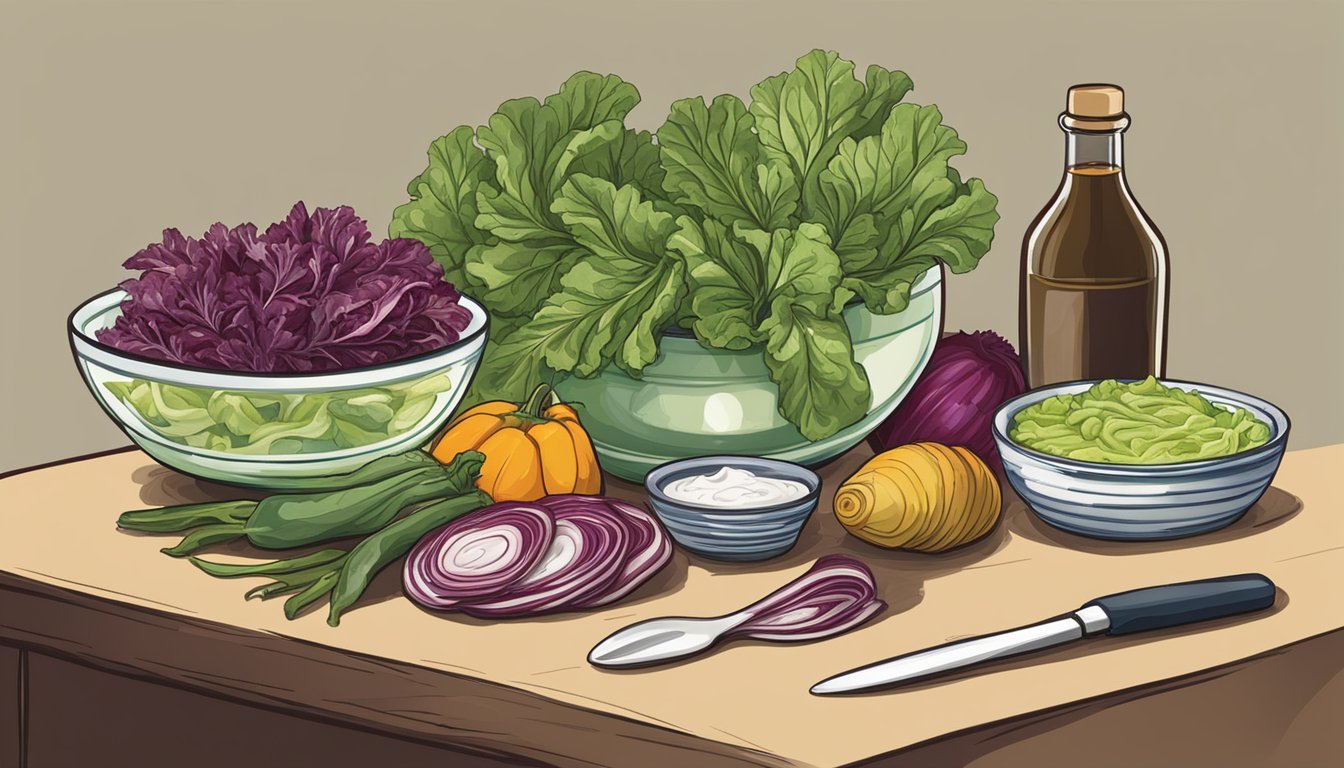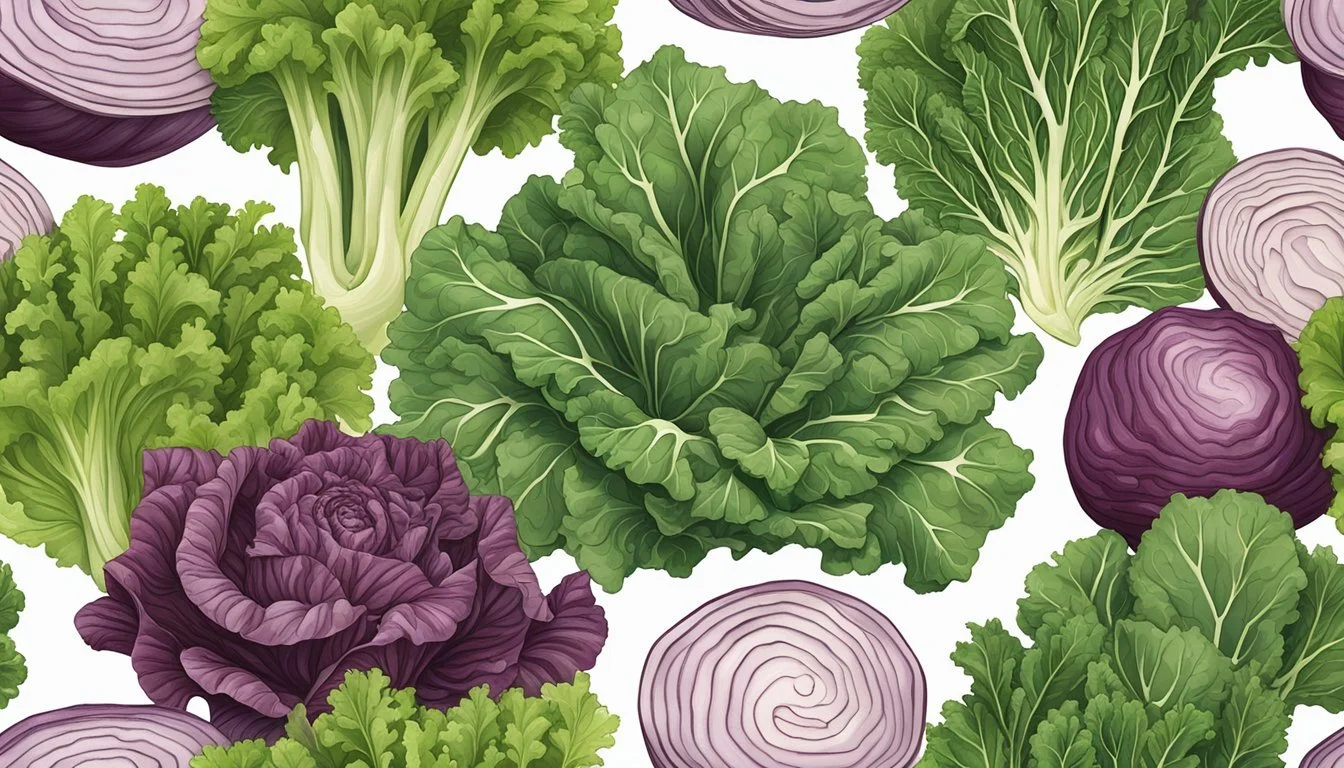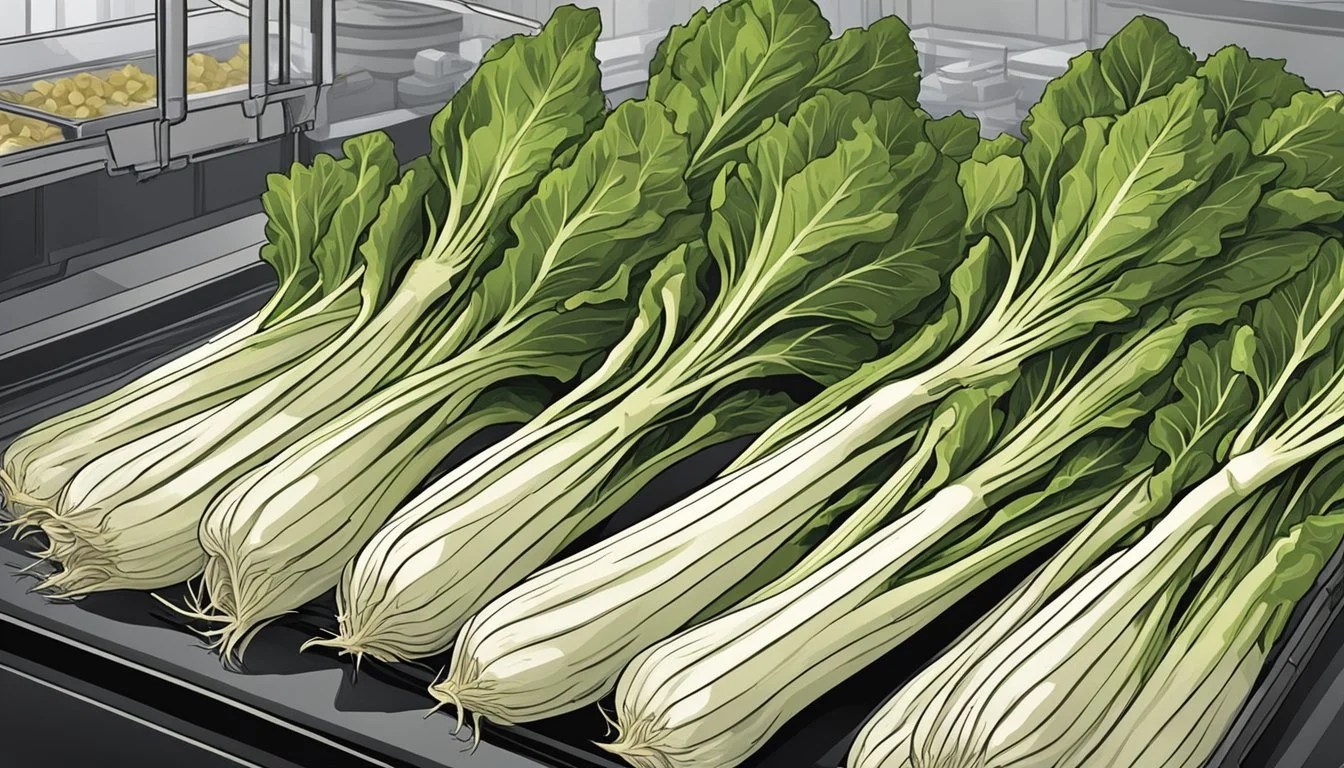Belgian Endive Substitutes
Top Alternatives for Your Recipes
Belgian endive, also known as witloof or chicory, is a crisp, mildly bitter leafy vegetable that adds a unique touch to a variety of dishes. If you're out of Belgian endive or looking for alternatives, radicchio, arugula, chicory leaves, watercress, napa cabbage, and romaine lettuce are all excellent substitutes. These substitutes not only match the crunch and sometimes the bitterness of Belgian endive, but they also bring their own unique flavors to the table.
Radicchio, with its bright red color and bitterness, can be a fantastic addition to salads or even grilled dishes. Arugula offers a slightly peppery taste that can substitute for the less intense bitterness of endive in salads. Chicory leaves, a close relative of endive, mirror its bitterness and texture, making them an ideal replacement.
Watercress provides a peppery bite and is especially good in fresh salads. Napa cabbage and romaine lettuce, while milder, offer crunch and versatility in numerous dishes from salads to wraps. Each of these substitutes ensures that your dish maintains both flavor and texture when Belgian endive is unavailable.
Understanding Belgian Endive
Belgian endive is a versatile leafy green known for its mildly bitter taste, making it suitable for various culinary applications. It offers numerous health benefits due to its rich nutritional profile.
Characteristics of Belgian Endive
Belgian endive, also called witloof or chicory, is a type of leafy green vegetable. It is typically pale yellow with tightly packed leaves and a slightly elongated shape.
This vegetable has a crisp texture and a mildly bitter flavor that distinguishes it from other leafy greens. Belgian endive is grown in the dark to prevent the development of chlorophyll, which keeps its leaves white.
This growing process also reduces its bitterness compared to other endive varieties, such as curly endive.
Culinary Uses
Belgian endive can be eaten both raw and cooked, making it a versatile ingredient in many dishes. When raw, it is often used in salads, providing a crisp texture and a hint of bitterness that complements various salad dressings and toppings.
In cooked applications, Belgian endive can be grilled, baked, or braised. Cooking enhances its natural sweetness and reduces its bitterness. It is commonly used in soups, stews, and casseroles.
The leaves can also serve as edible vessels for appetizers, holding dips, spreads, or finely chopped ingredients.
Health and Nutritional Profile
Belgian endive is not only low in calories but also rich in several essential nutrients. It provides a good amount of dietary fiber, which aids in digestion and promotes a feeling of fullness.
This leafy green is an excellent source of vitamins such as vitamin C, which supports the immune system, and vitamin A, necessary for vision and skin health.
Minerals like potassium and calcium are also present, contributing to cardiovascular health and bone strength. Additionally, Belgian endive contains antioxidants that help protect the body from oxidative stress.
Top Substitutes for Belgian Endive
Selecting an alternative for Belgian endive can depend on the dish and personal preferences. Each substitute offers unique flavors and textures, enhancing salads, soups, and roasted dishes.
Radicchio
Radicchio is a suitable substitute for Belgian endive. It is a bitter leafy vegetable that shares similarities in taste with endive. Its bright red color makes it a visually appealing addition to salads and garnishes. Grilling or roasting radicchio can also bring out its inherent sweetness, providing a complex flavor profile that is both bitter and slightly sweet. This versatility makes radicchio a widely recommended alternative.
Escarole
Escarole resembles endive but has broader, less curly leaves. Escarole is slightly bitter and robust enough to hold up in soups and stews, where Belgian endive is often used. Raw escarole is also a great addition to salads, lending a mild bitterness and crunchy texture. It is packed with nutrients like fiber and vitamins A and K, making it a healthful choice for an endive substitute.
Curly Endive
Curly endive, also known as frisée, is another member of the chicory family. It has a similar bitter flavor to Belgian endive but is generally more pronounced. The leaves are bright green and curl tightly, adding a unique texture to salads. Curly endive is excellent in raw applications and pairs well with robust dressings and ingredients that can balance its bitterness. It is also a good source of vitamins A and K.
Romaine Lettuce
Romaine lettuce may not have the bitterness of Belgian endive, but it is similarly crisp and can add a refreshing crunch to salads. It's a versatile green that is widely available and easy to use in various recipes. Romaine also stands up well to grilling, adding a smoky dimension to its mild flavor. Nutritionally, it offers a good dose of vitamins A and C, making it a healthy alternative.
Chicory Leaves
Chicory leaves are closely related to Belgian endive, sharing a slight bitterness that can mimic its flavor. They work well in salads and cooked dishes, providing a similar taste and texture. Chicory leaves are also rich in inulin, a prebiotic fiber beneficial for digestion. With the added health benefit and comparable taste to endive, chicory leaves make a practical and nutritious substitute.
Arugula
Arugula differs from Belgian endive by having a peppery taste rather than a bitter one. Still, its vibrant flavor and tender leaves make it a good replacement in salads. Arugula can also be used in cooked dishes, though it wilts quickly. It's a nutrient-dense green, high in calcium, potassium, and vitamins A and C. For those who enjoy a peppery bite, arugula is an excellent endive substitute.
Alternative Greens to Consider
Exploring substitutes for Belgian endive involves understanding a variety of greens that offer similar textures, flavors, or nutritional benefits. Options like watercress, Napa cabbage, frisée, spinach, and kale each bring unique qualities to your dishes.
Watercress
Watercress is a nutrient-rich leafy green with a slightly peppery taste. It thrives in watery environments, making it a staple in salads and soups. Watercress has a crisp texture similar to Belgian endive, making it an excellent alternative in dishes that require crunch.
Rich in vitamins A, C, and K, watercress also provides significant health benefits. Its distinctive flavor can enhance sandwiches, wraps, and even as a garnish for various cooked dishes. Its slight bitterness can balance out rich or fatty meals.
Napa Cabbage
Napa cabbage is a type of Chinese cabbage with a mild flavor and tender leaves. Known for its subtle sweetness and high water content, it can be used raw in salads or cooked in stir-fries. The crunchy texture of Napa cabbage is comparable to Belgian endive, making it a versatile substitute.
Napa cabbage is rich in vitamin C and fiber, promoting digestive health and immune support. It absorbs flavors well, making it an ideal ingredient in kimchi, soups, and as a wrap for dumplings or spring rolls.
Frisée
Frisée, also known as curly endive, has a slightly bitter taste and a unique, curly appearance. It is often used in salads to add texture and visual appeal. The slightly bitter flavor of frisée can mimic the taste profile of Belgian endive, making it a suitable substitute.
Nutritionally, frisée provides vitamins A and K, which are important for eye health and blood clotting. Its delicate yet crunchy texture makes it ideal for mixed greens salads and pairs well with vinaigrettes that complement its bitterness.
Spinach
Spinach is a versatile green with a mild flavor and tender leaves. Unlike the more bitter Belgian endive, spinach offers a softer taste that can suit a variety of dishes, from salads to cooked preparations. Its high iron and calcium content make it a nutritious choice.
In addition, spinach is rich in vitamins A, C, and K, as well as folate and antioxidants. It can be used fresh in salads or wilted into dishes like pasta, quiches, and soups. Spinach’s adaptability makes it a popular and accessible endive substitute.
Kale
Kale is a hardy leafy green known for its dense nutritional profile and robust texture. Its slightly bitter taste can replace Belgian endive in recipes that call for a strong green. Kale can be used raw in salads or cooked in various dishes.
Full of vitamins A, C, and K, kale is also an excellent source of fiber and antioxidants. It stands up well to cooking methods such as sautéing, baking (as kale chips), and adding to stews. Its hearty leaves add substantial texture and nutrition to any meal.
Utilizing Substitutes in Recipes
Substitutes for Belgian endive, such as radicchio, watercress, and chicory leaves, can be effectively used in various recipes to maintain similar flavors and textures. Each substitute offers unique characteristics that can elevate the dish.
Salads and Wraps
When creating salads, radicchio and watercress are excellent alternatives. Radicchio’s bright red color and crunchy texture add visual appeal and crunch to mixed greens. Its bitterness, similar to endive, pairs well with sweet ingredients like pears and cranberries.
Using watercress in salads provides a peppery flavor and a tender texture. For wraps, consider using romaine lettuce or Napa cabbage for crispness and a sturdy structure. This can make wraps more refreshing, without compromising on the crunch.
Cooked Dishes
In cooked dishes, like casseroles and stews, substitutes such as kale and spinach work well. Kale's robust texture holds up in soups and stews, adding nutrients and a slightly bitter flavor. Spinach, with its softer texture, is suitable for gratins and pasta dishes, providing a mild taste that complements various ingredients.
Grilled radicchio enhances sweetness through caramelization, making it ideal for side dishes. Sautéed chicory leaves can impart a similar bitterness to Belgian endive, suitable for incorporating into mixed vegetable sautés or as a topping for cooked dishes.
Sandwiches and Garnishes
For sandwiches, romaine lettuce and arugula are popular choices. Romaine offers a crunchy base without overwhelming other sandwich ingredients. Arugula’s peppery bite adds a distinctive flavor to sandwiches and can be used as a garnish to enhance the taste visually and gastronomically.
Radicchio can also act as a colorful and bitter garnish for various plates. Watercress, with its small leaves and tender texture, can serve as a finishing touch for open-faced sandwiches or canapés, providing a fresh and slightly spicy note.
Using these substitutes thoughtfully maintains texture and flavor integrity in recipes, allowing for flexibility and creativity in cooking.
Taste and Flavor Profiles
Belgian endive is known for its slightly bitter, nutty flavor and crisp texture. Understanding how to balance these characteristics can help in selecting the best substitute for your culinary needs.
Balancing Bitterness
Belgian endive has a distinct bitterness that can enhance many dishes. Radicchio brings a sharper and zestier bitterness, ideal for salads and grilling. If a milder substitute is desired, escarole offers less bitterness while still contributing to the desired taste profile. Chicory leaves can also provide a slight bitterness similar to endive, making them a fitting replacement.
Enhancing Sweetness
While Belgian endive itself is not particularly sweet, some cooking methods, like grilling or roasting, can highlight its subtle nutty notes. Radicchio, when grilled or roasted, develops sweeter undertones that can be a pleasing counterpoint to its bitterness. Napa cabbage is another alternative that has a mild sweetness, especially in cooked dishes. Using watercress can also add a slight peppery taste with hints of sweetness.
Achieving Ideal Crunchiness
Crunchiness is a vital characteristic of Belgian endive, especially in raw preparations like salads. Napa cabbage offers a similar crispy texture, making it a great substitute for raw applications. Romaine lettuce provides a crisp bite and is widely available. Curly lettuce and collard greens can also be used to achieve the desired crunch in various dishes, whether raw or lightly cooked.
By understanding these aspects, cooks can suitably replace Belgian endive with other vegetables that match the needed flavor and texture.
Considerations for Substitute Selection
Selecting the right substitute for Belgian endive depends on matching its key characteristics, such as texture, nutrition, color, presentation, availability, and seasonality.
Texture and Consistency
When selecting a substitute, it's essential to consider texture and consistency. Belgian endives are known for their crisp and crunchy texture. Suitable alternatives like radicchio, arugula, and watercress offer similar crunch and firmness.
Radicchio provides a sharp crunch, particularly when raw. Arugula is softer but still offers some crispness. Watercress has a slight crunch along with a peppery taste, making it a viable substitute. Napa cabbage and romaine lettuce also provide the desired texture, especially when used in salads or as a base for appetizers.
Nutrition and Diet
The nutritional profile of substitutes is equally important. Belgian endives are low-calorie and rich in vitamins like Vitamin C, Vitamin A, and Vitamin K. Arugula and watercress match these nutritional benefits with high levels of vitamins and antioxidants.
Radicchio is another excellent substitute, containing antioxidants and vitamins that support health. Chicory leaves are rich in fiber and help with digestion, while napa cabbage and romaine lettuce provide essential nutrients without adding many calories. These substitutes meet dietary needs while maintaining health benefits.
Color and Presentation
The visual appeal of a dish can be significantly impacted by the color and presentation of its ingredients. Belgian endives have a pale or greenish hue that can be matched by napa cabbage and romaine lettuce.
To add variety and visual interest, radicchio's bright red color is an excellent choice. It not only enhances the dish aesthetically but also provides a bitter flavor that complements many recipes. Arugula offers a deep green color, contrasting well with other ingredients and adding a fresh, vibrant look to dishes.
Availability and Seasonality
The availability of substitutes can influence selection, as Belgian endive is sometimes difficult to find. Arugula and romaine lettuce are widely available year-round, making them convenient choices.
Radicchio and watercress are more seasonal but can usually be found in specialty stores. Chicory leaves might be less common but are worth seeking out for their unique flavor and texture. Napa cabbage tends to be more readily available, especially in Asian markets, ensuring that substitutes are practical and accessible to most consumers.
Each of these factors should be considered to provide the best possible replacement for Belgian endive in any recipe or dish.
Storage and Preparation of Substitutes
Proper storage and preparation techniques ensure that substitutes for Belgian endive retain their quality and flavor. Focusing on specific methods helps maintain their texture, taste, and nutritional value.
Proper Storage Techniques
Storing substitutes like radicchio, arugula, and chicory leaves correctly extends their shelf life. Refrigerate them immediately after purchase. Use perforated plastic bags for storage to improve airflow and prevent moisture buildup.
Maintain the refrigerator temperature between 32°F and 36°F. Avoid storing leafy greens in the fridge door to prevent temperature fluctuations. For short-term storage, use the crisper drawer to balance humidity.
Preparation for Cooking
Before cooking, wash the vegetables thoroughly to remove any dirt or pesticides. Dry them using a salad spinner or pat them dry with paper towels.
Radicchio and chicory leaves are best suited for grilling or roasting to enhance their natural sweetness. Arugula and watercress can be added fresh to salads or lightly sautéed. Keep preparation methods straightforward to preserve their nutrients and flavors.
Optimizing Shelf Life
To optimize shelf life, remove any wilting leaves before storing the substitutes. Keep leafy greens away from ethylene-producing fruits like apples and bananas, which can cause premature wilting.
If you need to freeze leafy greens, blanch them first by boiling for a few minutes, then immediately place them in ice water. Store them in airtight containers or freezer bags, and label them with the date. Properly frozen, they can last for up to 12 months without significant quality loss.
By following these guidelines for storage, preparation, and shelf-life optimization, readers can ensure their substitutes for Belgian endive are ready to use in any recipe.
Nutrition and Health Benefits
Belgian endive is a highly nutritious leafy vegetable, ideal for health-conscious individuals.
Vitamins and Minerals: Belgian endive provides essential vitamins such as vitamin A, vitamin C, and folate. These nutrients are critical for maintaining healthy skin, enhancing immune function, and supporting cell growth.
Fiber: High in dietary fiber, Belgian endive aids in digestion and supports a healthy gut. Consuming fiber-rich foods like Belgian endive can help regulate bowel movements and prevent constipation.
Antioxidants: Packed with antioxidants, it helps combat oxidative stress and protects cells from damage. Antioxidants play a role in reducing the risk of chronic diseases such as heart disease and cancer.
Low in Calories: Belgian endive is low in calories, making it an excellent choice for those looking to manage their weight. Despite its low-calorie content, it is nutrient-dense and fulfilling.
Hydration: With high water content, Belgian endive helps keep the body hydrated. Maintaining hydration is essential for overall bodily functions and skin health.
Minerals: Rich in minerals like potassium and calcium, Belgian endive supports cardiovascular health and strong bones. Potassium helps regulate blood pressure, while calcium is vital for bone density.
By incorporating Belgian endive into your diet, you can enjoy these numerous health benefits in a flavorful and nutritious way.
Conclusion
The bottom line is that several versatile alternatives can successfully replace Belgian endive in various dishes.
Radicchio, with its bitterness and crunch, is excellent in salads and adds vibrant color to dishes.
Arugula offers a peppery flavor, suitable for raw dishes or lightly sautéed recipes.
Chicory leaves mirror endive's bitterness and work well in similar preparations.
Watercress provides a milder taste, perfect for cold dishes like sandwiches or salads.
Napa cabbage and romaine lettuce can also be used, though they offer different textures and subtle flavors.
These substitutes fit into a variety of cuisines, providing flexibility in both texture and taste.
Using these alternatives ensures your dishes remain flavorful and appealing.










